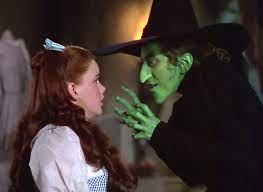What a world, what a world!
 At the climax of the movie, we barely notice her cry of desperation, so relieved are we at the victory of her adversary, the young heroine, Dorothy. Just a moment before, Dorothy and her friends were surrounded by armed guards and heard the sentence of execution one by one, with the last to die witnessing the torturous end of each of the others. There seemed no way of escape, but, as the Wicked Witch of the West lit her broom to ignite and incinerate the Scarecrow, Dorothy’s quick but misaimed response with a pail of water melted the witch into a steaming puddle. Our heroes’ danger is mitigated, the long-abused guards are grateful, and we can breathe calmly again.
At the climax of the movie, we barely notice her cry of desperation, so relieved are we at the victory of her adversary, the young heroine, Dorothy. Just a moment before, Dorothy and her friends were surrounded by armed guards and heard the sentence of execution one by one, with the last to die witnessing the torturous end of each of the others. There seemed no way of escape, but, as the Wicked Witch of the West lit her broom to ignite and incinerate the Scarecrow, Dorothy’s quick but misaimed response with a pail of water melted the witch into a steaming puddle. Our heroes’ danger is mitigated, the long-abused guards are grateful, and we can breathe calmly again.
But if we listen carefully, we also witness the witch’s heart-wrenching and profound cry of distress. As she disintegrates, she laments, “Oh, what a world! What a world!” She has lived her entire life relying on her evil power to provide sustenance and meaning, but in an instant, that power is unmasked as empty impotence in the face of the goodness of a child. Her whole purpose in life is exposed as emptiness: “Who would have thought a  good little girl like you could destroy my beautiful wickedness?” This cry is an expression of profound suffering, of pain at the deepest level of existence. Her wickedness, her meaning, her spirituality if you will, cannot be reconciled with the fact of her imminent demise, and with the actuality of how it came about. All she has believed, everything she based her life on, crumbles as she faces the ultimate reality.
good little girl like you could destroy my beautiful wickedness?” This cry is an expression of profound suffering, of pain at the deepest level of existence. Her wickedness, her meaning, her spirituality if you will, cannot be reconciled with the fact of her imminent demise, and with the actuality of how it came about. All she has believed, everything she based her life on, crumbles as she faces the ultimate reality.
My friend, hospice chaplain extraordinaire, Rev. Chuck Behrens says that, at its core, most of the spiritual pain, the existential distress that people suffer from at the end of their lives, is caused by conflict between what the person believes and what they know. Sometimes this is between our near-universal human attitude, the lived belief that tomorrow will come and will be sufficient for accomplishing life tasks like mending relationships, and the medical information that time is short and tomorrow is uncertain at best. At other times, the issue is suddenly recognizing the that a superficially adhered-to religious belief system of a lifetimes is inadequate or poorly suited to handle the profound questions posed when death looks us in the eye. This conflict often causes anger, sadness, and regret, but the near-universal emotion is fear, often accompanied by profound loneliness.
When a person learns of a terminal diagnosis, their impending demise becomes a prominent if not the primary part of their identity, an identity that is novel and foreign to their previous self-image. Denial, rebellion, anger, and fear are normal defense mechanisms here, but if time is very short, if they are actively melting like the witch, these increase rather than alleviate the suffering. Unfortunately, our societal approach to the dying, our death-defying attitude means that many of these people feel that they must work this through themselves, as the world around them goes on as usual, as if the earthquake they feel is theirs alone.
The point here depends on who we are in the story. Today, I will take on the easy one: the liquefying witch could have found peace at the end of her life if she had been able to take the next step beyond her admission of defeat and failure and look for forgiveness and reconciliation. But with only about 27 seconds of run time between the water splash and her dissolution, that is hardly possible.
It is more than likely that each of us today has more than 27 seconds to live, so we have the opportunity to decrease the likelihood of spiritual suffering when we come to the end of our lives. This starts with honesty, with recognizing that death will come for us, with noticing how that fact makes us feel, what it urges us to do, and then doing just that.

